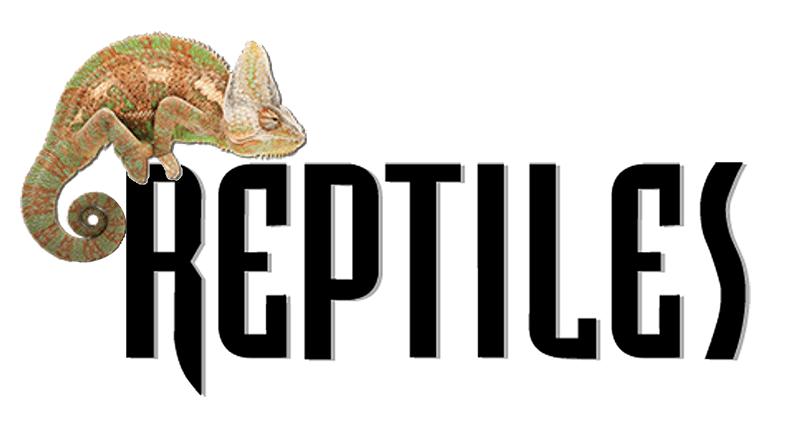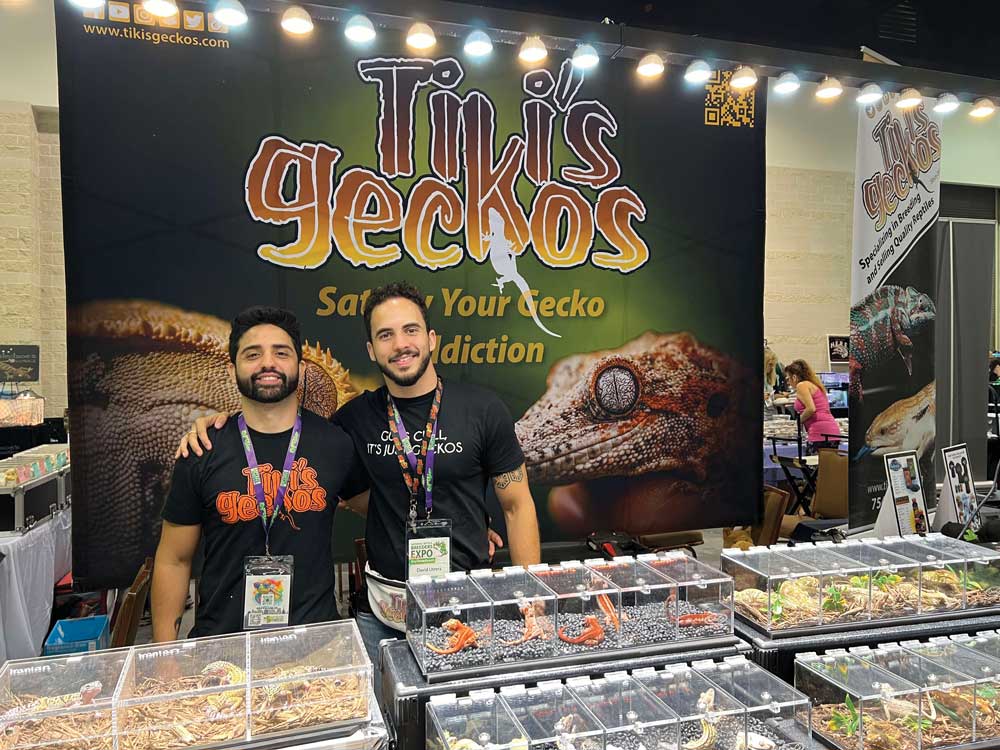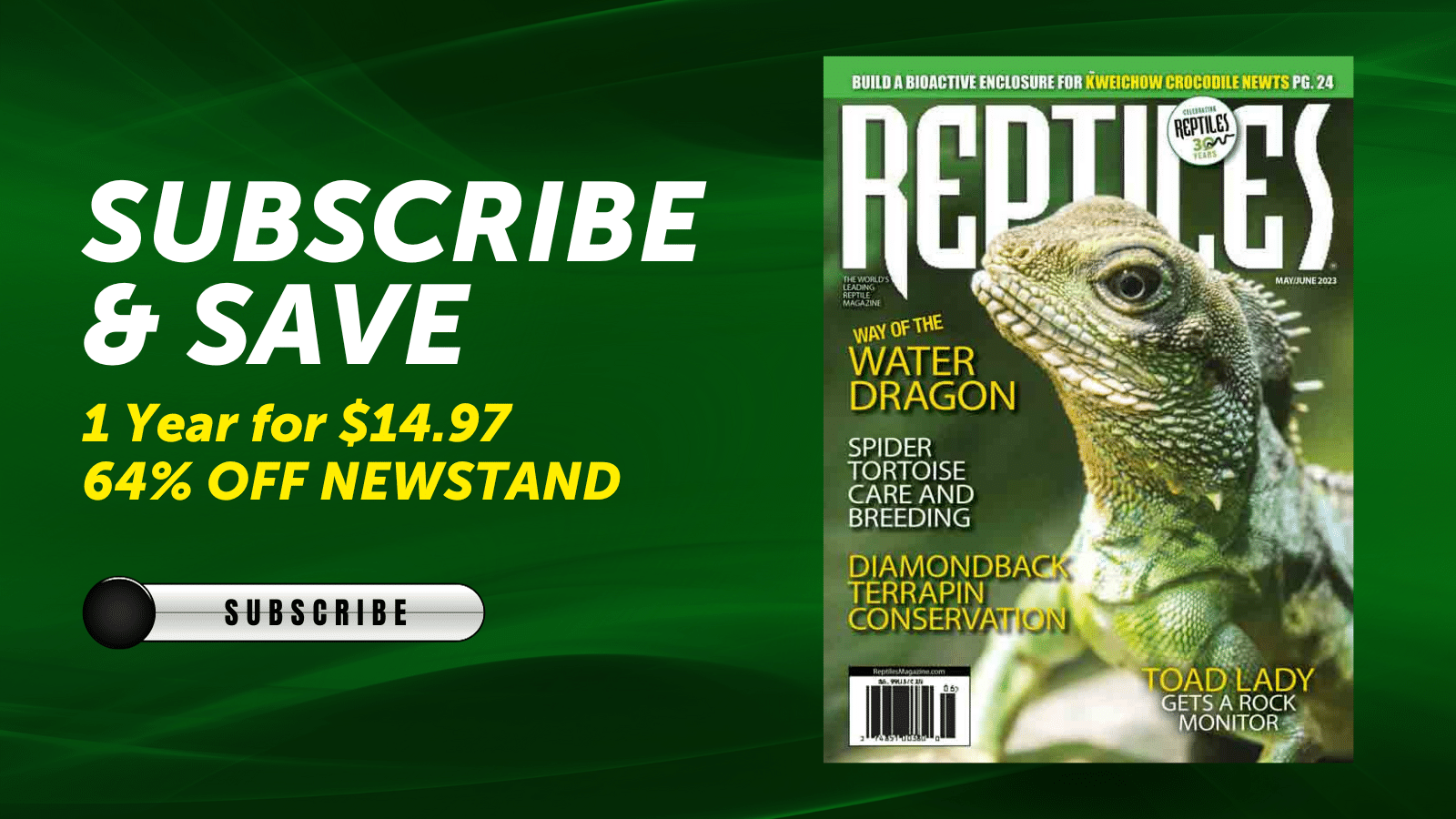Tikis Geckos is a name familiar to many in the herpetocultural hobby, particularly those keeping high end gargoyle and crested geckos.
Tikis Geckos is a name familiar to many in the herpetocultural hobby, particularly those keeping high end gargoyle and crested geckos. Started in 2011 in his parents’ garage, founder David “Tiki” Utrera and his friend Manny Durand have since grown the business into a full-scale breeding operation. Tikis Geckos is known for producing mind-blowing color morphs of both gargoyle and crested geckos. In addition, David and Manny also work with other geckos, various skinks, bearded dragons, amphibians, invertebrates, and snakes just to name a few.
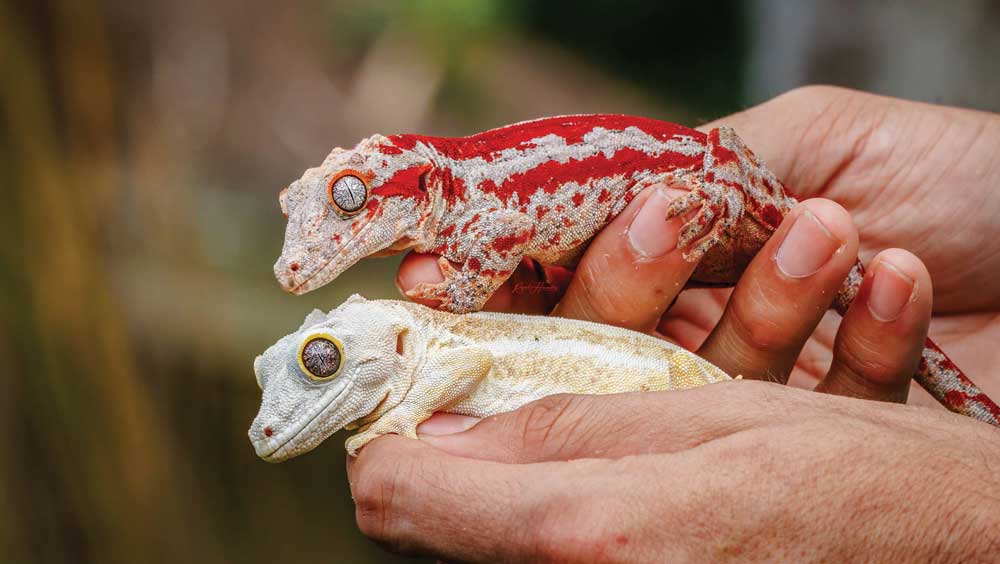
Tiki’s Geckos started with a wholesale package of 50 geckos.
Beginning in 2012 Tiki’s Geckos became an online presence on various social media platforms. Quality production, knowledgeable content, and an easy-going screen presence quickly earned David and Manny a loyal following. Recently surpassing 105,000 subscribers on YouTube, the pair continue to upload videos on a regular basis.
FR: Before we begin, I want to say thank you for agreeing to participate in this interview. Your website and videos provide an excellent introduction to your background so I will refrain from asking much of the same information. This said, tell us about your favorite childhood memories involving either herps or other animals.
David: When I moved to the United States, I was obsessed with reptiles. I had an uncle that bred snakes and he married my aunt. He is an American guy and he introduced me to the world of reptiles. He would take me to reptile shows and show me all the different species of lizards and snakes that were available to keep as pets. After a while I was persistent that I wanted a pet lizard, like an iguana. When they went back home, they shipped me a bearded dragon. Just having that first bearded dragon was really what started everything for me.
Manny: My first chameleon, when I was 19, so I came out a little late. I was into fish first, that was my first love. When I got my chameleon, I saw it for the first time, it absolutely blew my mind I didn’t realize that an adult could look this pretty. It put me on the path that I am on today. I saw that animal and I thought oh my goodness I have to make more of these. It was a phenomenal pet too. To this day it was my favorite pet reptile that I have ever had.
FR: How did you first meet and what led to your business partnership?
David: My family has always been very business oriented. I have uncles and other family that have started their own businesses, that is always how we have been. I was in high school when I really started to think about this as a business. When I saw that there was a big breeder that offered a wholesale package of 50 geckos, I asked my mom and my dad for a loan of $1500.00. I pitched to them that I was going to try to keep some of the geckos that I like the most but the other ones I could sell for at least 100.00, twice what I paid for them. I would recoup the money and even make some profit out of it. I got the big group of geckos and decided to turn it into a business, calling it Tiki’s Geckos. I then started promoting it. At that time, we were bigger into the forums like the Pangea Forum. People would interact with me that way a lot but as time passed on, I realized that we had to put our hands in all the different cookie jars as far as media goes like YouTube, Instagram, Facebook, and others.

Tiki’s Geckos is well known for crested geckos and gargoyle geckos. Photo by Tiki’s Geckos
Manny: So back in high school I had some great Betta fish, and I would sell them across the country as well, but I never thought about it as a business, I just enjoyed doing it. What really got me into lizards was Tiki. We were friends in high school and after high school we became really close. I remember coming over to his house and him showing me the garage and we just started hanging out more and more. There were many nights that I would be there until 1 in the morning just helping him feed geckos, and not making any money out of it (Manny says as he smiles at David and they both laugh). He introduced me into this whole world of reptiles, this is what really got me into it.
FR: I am going to guess that perhaps your most famous gecko is Deadpool. When did he hatch and what went in to producing such a gorgeous lizard?
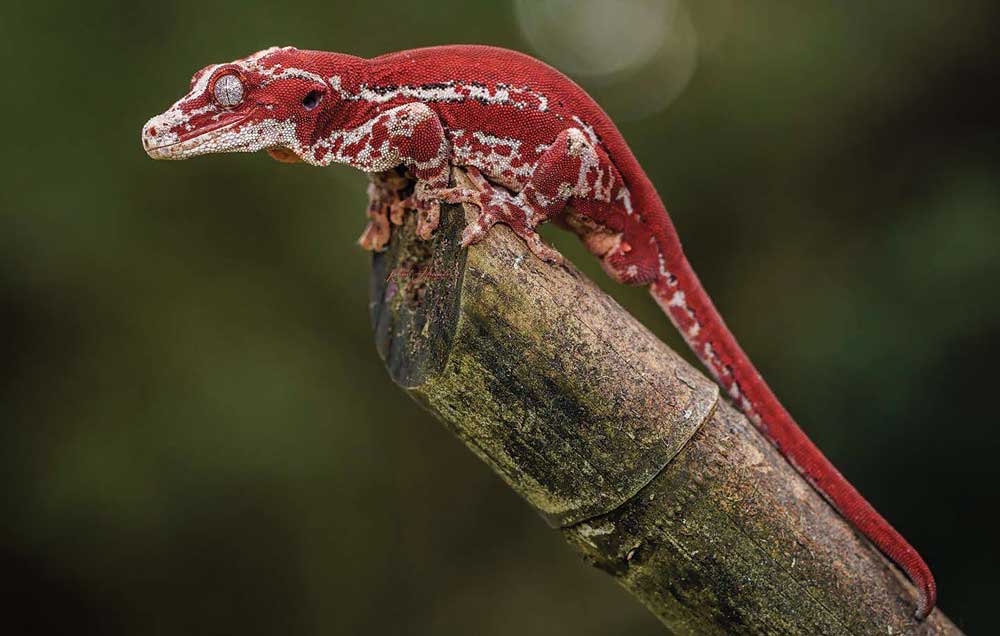
Deadpool red stripe gargoyle gecko.
David: Deadpool was originally produced by Phillip Tremper, an old school guy that has many years of experience. I think that he has been breeding gargoyle geckos longer than I have been alive. He has really perfected his craft. He had sold it to another buddy of mine in Florida and I remember seeing the gecko and just bugging him about it. At that time, he was just breeding them and eventually he decided that he was getting out of geckos to take care of his kids, so he decided to sell. I was the first person that he contacted because he knew how much I wanted that gecko. Around that time the first Deadpool movie was popular, so I thought that was a good name. I have had him for over 10 years, and he is still producing.
FR: Tell us about the Gold Standard Gecko Club.

David: The Gold Standard Gecko Club is a nationwide competition for geckos similar to the AKC for dogs. What started it was my dog that you saw earlier, an American Bully. That was my first dog and I started really getting into the competitions. With geckos, over the past couple of years, especially with the influx of new breeders during Covid, there are a lot of people breeding for the morph, and not so much for the overall quality of the animal. I decided that it was a good idea to basically start promoting and telling people that hey, we shouldn’t just look at the pretty colors and bold patterns. We really should start thinking about the longevity of these animals. We want to make sure that the animals basically have a good body structure, good facial features, not too buggy eyes. I have seen in the dog world that kind of stuff can easily and quickly become an extreme and then the animals end up having health issues because of it. That’s my main thing with this and what started me going into this venture.

Parameters for the Gold Standard Gecko Club. The Gold Standard Gecko Club was formed to ensure quality animals are bred.
FR: What advice would you give to those wanting to develop new morph combos of gargoyle and crested geckos?
David: My first advice that I always give is to follow what you like and not what the trends are. The trends go up and down and in circles. Work with what you like because over the next 5 or 10 years the value can change from high highs to low lows but if you develop quality animals over the course of that time period people will remember your name and your animals.
Manny: Breed for morphs and colors that you like, not what is popular because you can really burn out otherwise.
FR: Judging from your YouTube videos, your breeding facility looks amazing. Approximately how many enclosures would you say is on site?
David: I couldn’t count if I wanted to (both laugh).
Manny: Hundreds, especially counting the baby gecko enclosures.
FR: How many staff do you employ?
David: Me, Manny, my wife, my brother, and my dad. We all have different kinds of jobs.
FR: What is a typical day like at your facility?
David: Depends on who you ask (both laughing). My days are kind of different. Mine are more random, not so much on a schedule. A lot of media, talking to different customers, if a problem goes on like an issue with an order, a customer, or an animal, I’m usually the one that has to deal with it. At times we both have to pack orders, that’s mostly what my days consists of.
Manny: I essentially take care of everything that is not New Caledonian gecko, so everything else we have. I’ve got to make sure that everything is well taken care of, clean, fed, and then breeding also. Depending on the time of year you’ve got to make sure that stuff is paired up or brumating, or whatever needs to get done with that process. Setting up newborn babies with those animals as well. Whenever we get new stuff. Also packing, at the end of the day, we are packing all of the orders. I also try to do MorphMarket as much as I can. If a customer needs help with an animal I’m more familiar with then I will talk to them as well.
FR: If you had to pick one, what is your favorite species?
David: Somebody else asked me last month at the Reptile Super Show and I actually said tegus, if I had to pick one animal that I could keep. I am absolutely fascinated with lizards over snakes, so I would definitely go with a lizard. if I start breaking it down, I want something that is very intelligent and has a good size if I could only keep one. I love my monitors but for whatever reason I think that tegus are a little more docile, more forgiving when it comes to their care.

Tiki with the late Brian Barczyk.
Manny: It’s funny because I think I agree. Many years ago, before we even thought about tegus, we would get back from shows late at night and just sit in the back and talk. Sometimes we would say, if we had to get rid of everything what would we keep, and we said tegus. I couldn’t agree more with what David said. They are a good size, they are highly intelligent, they are like dogs. When we used to have them, I would just go into the cage sometimes and they would literally just hang out with me. I don’t think that I have ever enjoyed a reptile more than I have a tegu.
FR: Even though we all want to promote healthy, captive-bred animals, field collected species are still ever present in our industry. As anyone who has been in the hobby for a considerable length of time knows, the availability of many given wild caught animals tends to fluctuate. What is available today may not be seen again for years, if ever. Which species would you like to see hobbyists and breeders devote more effort on?
David: The downside to breeding species that are wild caught imports in big numbers is that they are so cheap when they come in that it doesn’t give incentive for breeders to work with them. Back in the day they had these little lizards called dragon agamas. They are little green lizards with diamond shapes on their back, they were from China and Asia. Those would have been nice. I always think like some of the more basic geckos that we take for granted like flying geckos, not a lot of people work with them. I know like maybe one or two breeders who work with them.
Manny: It’s funny that is exactly what I was going to say. I always said fire skinks. Most are imported. They would be incredible. They make great pets; they are super easy to take care of but nobody cares about them because they are common.
FR: Are there any additional species, perhaps not mentioned in your videos, that you plan to start working with in the future?
Manny: There’s a lot. Red-tailed boas, like one or two pairs. We have a lot of random stuff. Australian leaf-tailed geckos, Japanese cave geckos. Maybe finally successfully breeding some Abronia species.
David: We just acquired some Abronia lythrochilla that we are going to try to breed again here. The thing about those is they need a cool period and here in Florida it’s not very cold and not very constant, so we are going to try some other things to figure that one out. Something that I want to work with that I haven’t worked with in the past are knob-tails.

David “Tiki” Utrera and Manny Durand with a 100,000 subscriber YouTube award.
FR: You guys have propelled yourselves to a position of popularity in the herpetocultural world. Some of the videos that I have watched feature other prominent figures in the hobby, such as Tom Crutchfield and Dav Kaufman to name a few. What has it been like meeting and collaborating with other well-known herpers?
David: It’s awesome you know because a lot of these guys, especially Brian when he was alive, we looked up to him. We watched his videos way before any collaboration was in thought. Then to get to work with him, and he came here, we’ve gone there. It was awesome because I’ve heard this a lot, never meet your heroes because you will be disappointed but that was not the case whatsoever. He was just like he was in the videos, super enthusiastic all the time. He was one of the nicer people we’ve met for sure in this hobby, and just always positive. No negativity whatsoever, he was never talking crap about anybody. Obviously, Kaufman is another one that we have watched for a long time growing up in this industry. He is just an awesome guy and super funny and we always have a good time when he is around.
Manny: Jay Brewer of Prehistoric Pets, especially in the early days of Instagram, we have met a lot of cool people and it’s amazing that a lot of them have turned into actual friends.
FR: What advice would you give to those looking to start their own YouTube channel?
David: My advice is, to do what you like, like I said before. This is a type of business and type of project that you have to keep alive every single day. It’s not like you can do three, four, five, or even a hundred videos and then leave it like that. People are wanting your attention, wanting more, wanting to be fed, so you have to be creative and sit down and actually think about what you are doing. Whatever you do is going to be on the internet for the rest of your life so that is something that a lot of newer influencers I think don’t take into consideration. Anything that you would be proud to show your kids or show your parents, that would be my advice.
Manny: My best advice would be to keep grinding, don’t get frustrated because you don’t blow up overnight. Keep on working, keep on working, I think consistency is the most important thing.
FR: Since getting the breeding facility up and going, in addition to producing online content, what are some of the less enjoyable experiences that you have had relating to these areas?
David: So, for example last week I was going through gargoyle gecko groups, and I found a female that had a missing chunk on top of her head. Breeding animals is not as smooth as we make it seem on video, so accidents happen. One day the animals may wake up with an attitude, like I don’t like you, and they want to tear each other up. Whenever I deal with something like that, I have to take the animal out, I have to treat it, try to make sure that it pulls through and stays alive, those are some of our bad days.
Manny: I agree, or like when the animal passes and especially when it was one of your favorites. I remember one of the tegus that we used to have back in the day, she bred, and for whatever reason just never recovered well. Something happened when processing those eggs, she slowly faded and that one sucked. I mean they all suck but when you have one that is special, those are the worst.
FR: In your video on hybridizing species, you offer some thought-provoking and undoubtedly controversial opinions. Could you summarize for our readers some of the positive aspects that you see with intentional crossbreeding?
David: So, when it comes to chahoua and crested geckos, you produce those hybrids and they are some of the most beautiful geckos in the world. It stirs the imagination of a lot of people, even outside of our small circles. Whether it is outside the circle of geckos or outside the circle of reptiles, it catches their attention. I think ultimately that is a good thing, as long as you are being honest and educating people along the way. Now what a lot of people don’t like about the hybrids is that when they start looking too close to the original species and they fear those animals will go back into the gene pool and breed and it will, you know, basically like cause a species to lose its purity.
The chahoua and crested gecko hybrid is so far different from any crested or any chahoua that I don’t ever see that being an issue. This is purely for the pet trade and ultimately the pet trade is what gives life to our hobby. That is something that is important to keep in mind because although there are ugly parts about our hobby and trade there are also so many beautiful things that give so many of us purpose in life. Some of those little things like that make the whole hobby what it is today.
Manny: For certain species hybridization can be very good. Species with a very limited gene pool. The Australian blue tonged skink is a good example. We can’t get any from Australia for over 20 to 30 years now. After all the line breeding, we are seeing under bites, over bites, kinked tails, so by hybridizing with another species of blue tongue, in theory we can develop a stronger, better animal with less issues.
David: We have seen that in Australia when they started producing these albino BTS. They were originally the Easterns and because they were not too vigorous, they cross bred them to Northern blue tongues and now they have a line that can supply the pet trade. That’s when they really took off, when you crossed the Easterns with the Northerns.
FR: Outside of the animals, what other interests and hobbies do you enjoy?
David: My other interests include mixed martial art training and traveling.
Manny: Fishing and Star Wars.
FR: Once again thank you so much for participating in this interview, are there any final thoughts that you would like to share to our readers?
David: I guess my final thoughts would be like, this hobby is kept alive by all of us that have this passion for it. Breeders may have a lot of animals but what really makes up this hobby is all of the smaller enthusiasts that share their passion through social media or through their friends. They get a friend that has never seen a reptile or amphibian and they come to their house, and they take it out and they have this kind of out of world experience, where you would never even think that an animal could look like that. It just like opens their mind into a different world. Ultimately what we want to do is spread our hobby, we want to show everybody how awesome and cool and beautiful these animals are. This hobby is made up of all of us, even the smallest hobbyist, and anytime you get an animal in front of people that have never seen one before. This is a good thing.
Manny: I think David hit everything right on the head, it is exactly like I feel, there are more to pets than just a dog and a cat.
